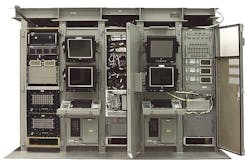Navy asks Lockheed Martin to upgrade AN/BLQ-10 submarine electronic warfare (EW) system
Officials of the Naval Sea Systems Command in Washington are asking the Lockheed Martin Rotary and Mission Systems segment in Syracuse, N.Y., to modernize the AN/BLQ-10 submarine EW system, which provides automatic detection, classification, localization, and identification of potentially hostile radar and communications signals at sea.
The AN/BLQ-10 is for Virginia-, Los Angeles-, and Seawolf-class fast-attack submarines, Ohio-class conventional guided-missile submarines, and future Columbia-class ballistic-missile submarines. It is not for existing Ohio-class ballistic-missile submarines.
The order calls for Lockheed Martin to provide upgrade kits and spare parts for the AN/BLQ-10, covering advanced processor builds and technology insertion (APB/TI) cycles TI-20, TI-22, and TI-24. Efforts include engineering, software development, hardware and software integration, and integration of government-furnished material.
Related: Unmanned submarines, electronic warfare (EW) and cyber: the Navy's role in offset strategy
The AN/BLQ-10 processes signals from the submarine’s imaging mast or periscope when the boat is at periscope depth. It provides threat warning to avoid counter-detection and collision; determines the number and location of targets for subsequent prosecution; and conducts intelligence, surveillance, and reconnaissance (ISR) to support the fleet or battle group.
The program is adopting an open-architecture, incremental development process that fields hardware and software technology insertions every two years. The AN/BLQ-10 blends modular interoperable systems that adhere to open standards with published interfaces.
The system's first technology insertion in 2008 added a subsystem to intercept some low-probability-of-intercept radar signals. Fielded upgrades from the 2010 technology insertions updated commercial off-the-shelf (COTS) processors and displays, and Improved Communications Acquisition and Direction Finding (ICADF) system.
Related: New era dawns in ASW as manned and unmanned submarines team for bistatic sonar
TI-12 upgrades have been fielded on advanced-model Los-Angeles-class attack submarines (SSN 688I) to include new and more powerful computer servers; and standardize the system's cyber security process.
TI-14 upgrades were scheduled for completion this year for 688I submarines and new-construction Virginia-class submarines. It not only updated COTS processors and displays, but also upgraded the system's Electronic Warfare Server First Generation, which provides its electronic support system operator and platform decision makers with improved tactical situational awareness.
This latest order is for AN/BLQ-10 TI-20, TI-22, and TI-24. For TI-20 it calls for Lockheed Martin to build an upgraded AN/BLQ-10 for Virginia- and Columbia-class submarine new construction, and in-service Virginia-class modernization.
Related: General Dynamics to continue software upgrades on Navy AN/BYG-1 submarine combat system
TI-22 work will provide upgraded AN/BLQ-10 systems for in-service Los Angeles- and Seawolf-class attack submarines, as well as for Ohio-class conventional missile submarines. TI-24 work will build an upgraded AN/BLQ-10 for Virginia-class and Columbia-class new construction, as well as for in-service Virginia-class modernization.
This order also calls for Lockheed Martin engineers to define an interface baseline to connect the AN-BLQ-10 to the submarine imaging system, carry-on equipment, and Submarine Warfare Federated Tactical System (SWFTS) network. Lockheed Martin also will carry out cyber security measures.
On this order Lockheed Martin will do the work in Syracuse, N.Y.; Manassas, Va.; and Moorestown, N.J., and should be finished by December 2020. For more information contact Lockheed Martin Rotary and Mission Systems online at www.lockheedmartin.com, or Naval Sea Systems Command at www.navsea.navy.mil.
Ready to make a purchase? Search the Military & Aerospace Electronics Buyer's Guide for companies, new products, press releases, and videos
